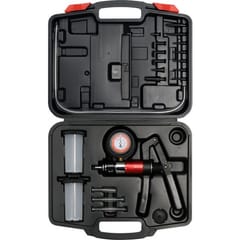A vacuum pump is a multifunctional device used to diagnose systems in cars and technology, the operation of which is based on pressure or vacuum.
It is equipped with accessories that can be used in almost any engine or system.
The YT-0674 pump is equipped with a switch that, depending on the position, allows you to create a vacuum or pressure.
Moving the switch towards the pump outlet will cause that a vacuum will be created during pumping.
A switch moved towards the handle will cause pressure to be generated during pumping.
Measuring range: -1 to 3 bar
Purpose / Application
With the help of a pump, diagnostics can be carried out m.in the following systems and systems.
Computerized engine control equipment:
- barometric pressure sensor (BARO)
- PVC system
- exhaust gas recirculation (EGR) system
- thick-film pressure sensors (MAP) Ignition control devices:
- vacuum ignition advance
- delay valve: SDV, RCV VBrake system:
- classic brakes
- ABS brakes
- air brakes
- brake lines
- brake servo
Other systems:
- air conditioning
- cruise control
- fuel tank and fuel installation
- vacuum door closing system
How to use
Exhaust Gas Recirculation System (EGR) Diagnostics The valve of the EGR system is an example of a valve actuated by vacuum.
In the absence of vacuum, the valve is closed and the exhaust gases do not escape from the valve.
If a vacuum is supplied to the valve, it is opened to allow exhaust gas recirculation.
Diagnostics of thick-layer pressure sensors (MAP)
•Assemble the pump and tank system as in the case of bleeding brake calipers, and then connect to the vacuum connection of the sensor.
•Press the pump lever until the hand shows -0.5 bar.
Finish pumping and observe the pointer, it should be stationary.
If the pointer is moving, the MAP sensor is damaged. •
During operation, the MAP sensor sends feedback signals to the control computer.
The signal has a frequency between 85 Hz and 160 Hz depending on the vacuum level.
A frequency meter is necessary to measure the frequency, it must be connected according to the instructions of the sensor and the meter.
Bleeding of brake calipers. •
Ensure that the expansion tank of the braking system is filled with fluid to the nominal volume. •
Carry out venting in the following order:
- the master cylinder, if fitted with a vent valve,
- brake calipers in order from the nearest master cylinder to the farthest.
•Connect a short hose to the connection located on the bottom of the pump tank cover.
•Close the pump tank with the lid.
•Connect long hoses to the cover connections.
Connect the end of one of the long hoses to the pump and the other to the vent valve (calamite) of the brake caliper.
Use the adapter if necessary.•Press the pump lever 10 - 15 times to create a vacuum in the pump tank.
•Unscrew the vent valve by 1/4 - 1/2 turn so that the pump tank fills with liquid to a height of about 5 cm.
Tighten the vent valve.
•Disconnect the pump line from the vent valve, the clamp venting procedure has been completed.
•Before repeating the bleeding procedure in the next caliper, empty the pump tank of brake fluid and top up the brake fluid level in the brake system to the nominal
VACUUM-PRESSURE PUMP 22 PARTS


€53.67
Shipping from warehouse: U1
Estimated shipping: Wed, Apr 2 - Mon, Apr 7
14 days returnUnconditional return policy
Despite our best efforts, we cannot guarantee that the published technical data and photos do not contain inaccuracies or errors, which, however, cannot be a basis for claims.


